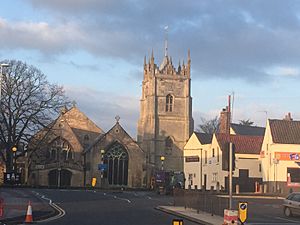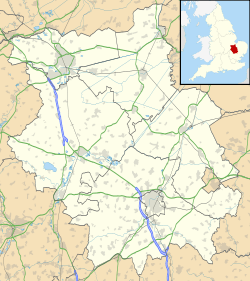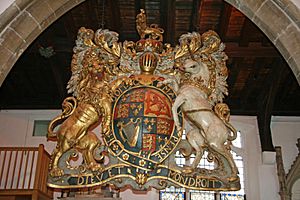St Peter and St Paul's Church, Wisbech facts for kids
Quick facts for kids Church of St Peter and St Paul |
|
|---|---|
 |
|
| 52°39′50″N 0°09′43″E / 52.6640°N 0.1619°E | |
| Location | Wisbech, Cambridgeshire |
| Country | England |
| Denomination | Anglican |
| Churchmanship | Anglo-Catholic |
| History | |
| Status | Parish church |
| Founded | 1187 |
| Dedication | Saint Peter, Saint Paul |
| Architecture | |
| Functional status | Active |
| Heritage designation | Grade I |
| Specifications | |
| Bells | 10 |
| Administration | |
| Parish | Wisbech |
| Deanery | Wisbech-Lynn-Marshland |
| Archdeaconry | Huntingdon and Wisbech |
| Diocese | Ely |
| Province | Canterbury |
The Parish Church of St Peter and St Paul, often called St Peter's Church, is an Anglican church located in Wisbech, Cambridgeshire, England. It is an active parish church within the Diocese of Ely. This historic church was first built way back in the 12th century.
On July 17, 1951, the church became the very first building in Wisbech to be given a Grade I listed status. This means it's considered a building of special historical or architectural importance.
Contents
Exploring St Peter's Church
Sir John Betjeman, a famous writer, once described St Peter and St Paul's church as a "typical town church." It has a unique design with four aisles in its main area, called the nave.
Inside the Church
The inside of the church shows building styles from many different time periods. The oldest part, the Norman nave, is to the north. There's also a second nave, and both have side sections called aisles and special areas for the altar called chancels. The original Norman chancel was replaced by a larger one with a beautiful east window.
The Bell Tower
One of the most interesting parts of the church is its bell tower. It stands separate from the main church building! This was done on purpose because the ground here isn't very stable. If the tower ever fell, it wouldn't damage the rest of the church. An older tower had actually fallen onto an earlier church building.
The tower becomes much more decorative as it gets taller. Many people who helped pay for its building are remembered in stone carvings. At the very top, there's a modern, pointed spire called a flèche.
The Church Bells
The tower holds a set of ten bells. These bells were remade in 1823. Two extra bells were added by a vicar named Rev. Abraham Jobson. These new bells are thought to be among the oldest sets of ten bells still in use.
For many years, a 'Workmens' bell would ring early in the morning at 5:45 am. A 'Curfew' bell would ring at 8:45 pm, telling people it was time to be home. These bells were restored and rehung in 1994, so they are still ringing today!
Churchyard and Cemetery
When the church's original graveyard became full, a new area called Tillery Field was bought in 1828 to be used as a cemetery. Many people who sadly died during the 1832 cholera outbreak are buried there. Today, this area is known as Tillery Park. The Church of England owns it, and the Fenland District Council helps to look after it.
Church Leaders Through Time
Over many centuries, St Peter's Church has been led by many different vicars. These leaders have guided the church community through various times in history, from before the Reformation to the present day.
The Rose Fair Festival
The Rose Fair is a special festival that started in 1963. It began when local rose growers sold rose buds inside the Parish Church. The money they raised helped to pay for repairs and improvements to the old church building.
Today, the church still uses the Rose Fair to raise money for its upkeep. However, the event has grown into a much bigger town festival! The gardens outside the church turn into a busy market. Other local churches and groups set up stalls and activities to raise money for their own causes. On the Saturday of the fair, the Wisbech Round Table organizes a parade of decorated floats that travel through the town.



